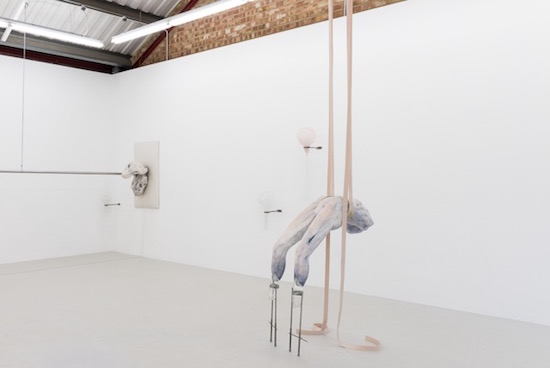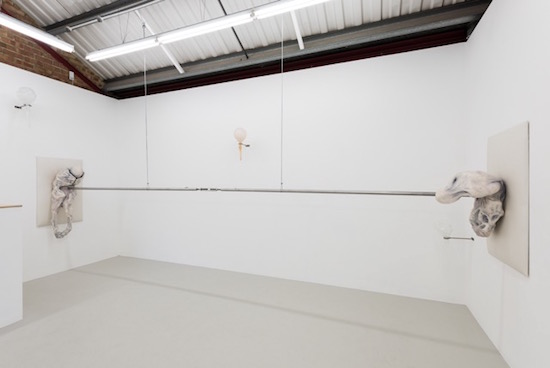The work of Ivana Basic takes its starting point from human flesh, in all its horror and ambiguity. Belgrade-born and New York-based, her current show at Annka Kultys’s gallery in Bethnal Green recently opened. It consists of a series of sculptural installations, all circulating around different aspects of a fictional character-cum-alter ego called Bridle, a kind of aesthetic Hyde to Basic’s Jekyll, a repository for the artist’s own sense of body horror and material alienation.
As the writer Courtney Malick explains in an accompanying text, “Basic methodically constructs Bridle, the character that embodies the tension of both the fundamental fragility of life as well as the violent force behind its suffocation … Throughout the exhibition and book, the character of Bridle is constituted on multiple levels. With Basic’s signature alien corporeality at the fore of her wax sculptures, Bridle gains physicality as she inhabits multiple pieces in the show, moving from one form to the other, the glass air vessels suspended on the walls show progression of Bridles breath, and lastly the written work that follows the exhibition, represents Bridle’s voice.”
To celebrate her first solo show at a London gallery, Craft/Work asked Basic a few questions about her work and ideas. Following that we are proud to reproduce a short extract from her new book, Throat Wanders Down the Blade, a collection of drawings and writings (cutting up her own words with those of Courtney Malick, Kafka, and Nabokov), released to accompany the exhibition.
Can you tell me about the development of your Bridle character? Who is Bridle? And how did this alter ego emerge from your practice?
Bridle emerged as a way for me to name and address the two forces I have been employing in my work so far. One being the force that propels life forward and the other one being the force that constrains life in order to bring its fragility and temporality to the fore. Thinking about the idea that every solid needs a void in order to architecturally survive, therefore every solid is infected by void and at the same time is a symptom if a void. With that in mind the pieces I made for the show are the solid, they are the bodies for the void, Bridle being the void within them, leaving her gradually suffocated breath within the glass vessels around the gallery walls. Aligned with this is the fact that all the bodies in my show are actually hollow, they are shells, habitats simulating the feeling of weight that is always present even though it is not real.
For how long have you been working with the writer Courtney Malick? How did you meet? Can you talk a little bit about the way you worked together on this project?
Courtney Malick is a writer and curator and we met a few years back when she was working on an essay in which she was writing about one of my pieces. For this show I wanted to use the opportunity of working together and working with language to communicate what couldn’t be communicated through material pieces, and that is the voice.
The pieces in the show are a reflection of internal forces which are not meant to be seen, and that is why two of the pieces in the show are hiding their faces away from the viewers, one by turning the head away from the viewers and the other by hiding her face within her own ribs, while the third one doesn’t have a face at all. In this way they can’t be witnessed. Consequently the voice we created was meant to sound and look on the pages as if it was never spoken and never heard. The thoughts in the text are scattered, only partially consequential, one can feel the breaths between them. Chapters show progression of the gaze and the voice, going from looking inwards into the body, through looking out of the body to turning the gaze against oneself. The text is written in order to relate to the reader the experience of being contained within the matter that will expire, within the limited space of the body. I feel the pieces in the show very intensely and I wanted the audience to feel them just as strongly through this text. Courtney offered the name Bridle referring to the horse harness as an apparatus to control, hold and constrict the life force.

What drew you to the words of Nabokov and Kafka? What made you want to include their words amongst your own in this publication?
These are the words that I have had in my mind for years, that started to merge with my own voice. Both Kafka and Nabokov have a relationship to their body that is very similar to my own reality. There is an absolute awareness of the temporality of this vessel we inhabit, its space, its boundaries, its weight its smell and there is a failure to identify with that vessel. Even though their thoughts were threaded in a completely different contexts from my own, I know they come from the same place my work comes from, so inscribing them into Bridle’s voice was a way to activate the full weight and potency of those words.
A lot of your sculptural work has dealt with externalising the body, making it something alien, segmented in a way that, to me, somehow recalls certain kinds of horror films. I wonder if you could comment on this aspect of your work?
I think that the connecting point between my work and the horror or science fiction films is fear. The body is given autonomy, which allows it a certain potency and, as you said, renders it alien. In doing so we have announced that the body can’t be contained or controlled and this is something that generates fear. I feel like, through my work I am taking down the curtain and revealing the brutal yet truthful and inevitable nature of the uncontrolled body.

CHAPTER 1
To Have A Name
She has always been there
A creature that follows me unfailingly … which I cannot bring myself to beat
Shunning her breath … I retreat step by step … yet she nevertheless … will push me into the corner
between the walls,
between the ribs,
the corner that I already see, there to decompose completely, upon me
and in me.
Her Name Is Bridle
She has no birthday,
She never grows old,
She was never an infant.
She is…
both solid and soft … the slow undetectable move towards the finitude
––yet the fall never comes.
She is both the blade and the cut – and inasmuch, they are one and the same.
She is not a part of the marital union to which her name recalls.
A stifling jewelry of sorts –– a facial harness that concedes power to a saddled usurper.
Bridle constrains, heels, curbs, and pulls a force back, reigns it in.
She allows –– the constriction of the innate bounding of life…
She is a noose … inconspicuously tightening its grip
…without which you rarely perceive you’re breathing.
Bridle’s face is that of your’s.
And mine…
Within her there are many others.
The tension between them fuels her
As one pulls inside of her, another one stretches
She is only the quivering impetus behind what makes us move,
as we must in relation to others.
—Text from Throat Wanders Down The Blade by Ivana Basic
Ivana Basic, Throat Wanders Down The Blade, is at Annka Kultys until 8 October. Subsequently, Ivana Basic’s work will be featured in the group exhibition ‘Dreamlands: Immersive Cinema and Art 1905-2016’ at The Whitney Museum in New York (28 October 2016 – 5 February 2017)


